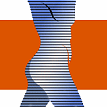Proctological diseases
The best known are hemorrhoids, but there are other proctological diseases.
Coccygeal fistula
What is a coccygeal fistula? Coccygeal fistula, also known as pilonidal sinus, is a disease of the skin and subcutaneous tissue in the area of the coccyx. It is usually caused by broken hairs that get under the skin and cause chronic or acute inflammation.
Various surgical techniques can be used as therapy. Medicinal therapy unfortunately does not lead to success. In contrast to anal fistula, coccygeal fistula has no contact with the rectum and does not originate from it.
We also have detailed information about coccygeal fistula on our blog: here
Anal fistula
What is an anal fistula? Sometimes an anal fistula is also manifested by persistent secretion from a hole, next to the anus. Important for the treatment of the fistula is its course through the sphincter muscle. That is why, in addition to the experienced surgeon, accurate diagnosis before surgery is important.
The fistula can be eliminated by different surgical methods, either by conventional surgery/resection, or by implantation of a so-called anal fistula plug, a “plug” that is inserted into the fistula tract. The surgical method with the anal fistula plug is gentler, and the cure rate is only about 60-70%.
Fissures
What is an anal fissure? Fissures are painful mucosal tears in the anal canal and can be treated conservatively while they are still fresh. Treatment with ointments can cure the condition permanently.
Sometimes Botox can be injected into the sphincter muscle as a supportive measure. In advanced cases, these are chronic wounds that scar like an ulcer. Then surgery can also help.
Abscess
What is an abscess? An abscess is often the result of a fistula that has become inflamed. It must be acutely relieved (cut open) to allow the pus to drain. The fistula should then be removed either immediately or at a later time.
Mariscuses
What are perianal thromboses or mariscs? These are lumps/skin folds on the rectum. They can be removed under local anesthesia or under short anesthesia if they are found to be bothersome. However, they can also be left in place and even disappear on their own without assistance.
Condyloma
What are condylomas or genital warts? Belongs to the proctological diseases. Anal condylomas (condyloma acuminata) or genital warts are lumps in the rectal and genital area transmitted by viruses (HPV, human papillomavirus). It is an infection through close contact with an infected person, often through sexual intercourse, e.g. anal intercourse. The partner should therefore also be examined. However, the infection is not transmitted exclusively sexually. The disease can lead to malignant disease if left untreated for a long period of time. In early stages, the disease can be cured with medication, but in cases of pronounced genital warts, surgical removal of the nodes is indicated.
Hemorrhoids
Hemorrhoids and other complaints in the rectal area have been successfully treated in our proctology practice in Munich for years.
The symptoms of hemorrhoids include itching, bleeding, oozing, burning, pain and nodule formation.
However, the symptoms mentioned can also indicate other rectal diseases, such as the frequent anal thrombosis and painful anal fissure, but also anal fistula with possible anal abscess, and finally malignant tumors.
We are specialized in the diagnosis and treatment of hemorrhoids and treat hemorrhoids according to their stage and very gently. Since the topic of hemorrhoids is a very extensive one, we have dedicated a page to it with questions and answers: Hemorrhoids – cause and symptoms and their treatment.
How to find us
Proctology and surgery practice Munich, directly at the subway station Max-Weber-Platz
Einsteinstrasse 1, 81675 München
Office hours
Mon 7:00-17:00
Tues 7:00-19:00
Wed 7:00-17:00
Thu 7:00-19:00
Fri 7:00-14:00
